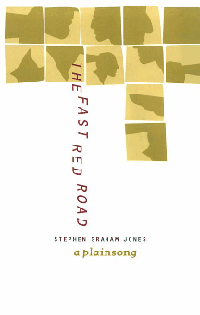The Fast Red Road
 First Edition Cover | |
| Author | Stephen Graham Jones |
|---|---|
| Cover artist | Jacket design by |
| Language | English |
| Genre | Novel |
| Publisher | Fiction Collective 2 |
Publication date | 2000 |
| Publication place | United States |
| Media type | Print (Hardcover, Paperback) |
| Pages | 326 pp |
| Followed by | All The Beautiful Sinners |
The Fast Red Road: A Plainsong serves as Stephen Graham Jones's debut novel written in 2000. He only started writing the book after being introduced to a Houghton-Mifflin editor (Janet Silver) at a party, and, for some reason, began telling a complicated lie about a book he had written. So, he went home that night and started it.
It was originally titled Golius: A Failed Sestina and used as Stephen's dissertation while attending Florida State University. After using a friend of his in New York to pose as a literary agent, Jones approached one of his professors who had offered to get it published to do so.[1]
Plot summary
The Fast Red Road—A Plainsong is a gleeful, two-fisted plundering of the myth and pop- culture surrounding the American Indian. It is a novel fueled on pot fumes and blues, a surreal pseudo-Western, in which imitation is the sincerest form of subversion. Indians, cowboys, and outlaws are as changeable as their outfits; horses are traded for Trans-Ams, and men are as likely to strike poses from Gunsmoke as they are from Custer’s last stand. Pidgin, the half-blood protagonist, inhabits a world of illusion—of aliens, ghosts, telekinesis, and water-pistol violence, where TV and porn offer redemption, and the Indian always gets it in the end. His attempts to reconcile the death of his father with five hundred years of colonial myth-making lead him to criss-cross a wasted New Mexico, returning compulsively to his hometown of Clovis, the site of his father’s burial.
Accompanied by car thief Charlie Ward, he evades the cops in a top-down drag race, tearing through barriers “Dukestyle.” The land they travel seems bent with fever—post-apocalyptic —as though the end has arrived and no one noticed. Its occupants hawk bodies and pastel bomb shelters, wandering a bleak hallucination of strip-joints, strip-malls, and all you can eat beef fed beef stalls. They speak a lingo of disposable nicknames, truncated punch lines—slang with an expiration date. Pidgin strays through bar and junkyards, rodeos and carnivals, encountering the remnants of the Goliard tribe. There’s the mysterious Mexican Paiute, Uncle Birdfinger, checkout-girl Stiya 6—the reincarnation of Pidgin’s mother—and media-queen Psychic Sally, who predicts the group’s demise. Each plays a part in the search that will eventually place Pidgin in a position to rewrite history.
Characters
- Pidgin
- Charlie Ward
- Uncle Birdfinger
- Stiya 6
- Psychic Sally aka Big Springs Sally
- Patience Patience
- Bonita Bonito
- Cline
- Silky Bird
- "Killer" Tom Black
- [2]
- Atticus Wean
- Weanie The Horse
- Litmus Jones
- Marina Trigo
Motifs
This section is empty. You can help by adding to it. (July 2010) |
Subtext
This section is empty. You can help by adding to it. (July 2010) |
Awards and nominations
The novel won the following awards: Independent Publishers Award for Multicultural Fiction[3]
See also
- All The Beautiful Sinners (2003)
- The Bird is Gone: A Manifesto (2003)
- Bleed Into Me (2005)
- Demon Theory (2006)
- The Long Trial of Nolan Dugatti (2008)
- Ledfeather (2008)
References
- ^ Jones, Stephen Graham. Interview with Jones at The Cult. [chuckpalahniuk.net]
- ^ A reference to Hal Borland's Tom Black from When The Legends Die
- ^ IndependentPublisher.com
